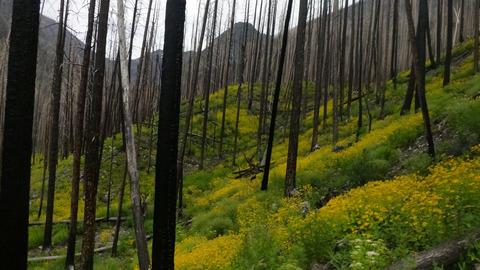当前位置:
X-MOL 学术
›
J. Appl. Ecol.
›
论文详情
Our official English website, www.x-mol.net, welcomes your
feedback! (Note: you will need to create a separate account there.)
Salvage logging management affects species' roles in connecting plant–pollinator interaction networks across post-wildfire landscapes
Journal of Applied Ecology ( IF 5.0 ) Pub Date : 2021-05-22 , DOI: 10.1111/1365-2664.13928 Laura A. Burkle 1 , Laura J. Heil 1 , R. Travis Belote 2
中文翻译:

打捞伐木管理影响物种在连接野火后景观中的植物 - 传粉媒介相互作用网络中的作用
更新日期:2021-05-22
Journal of Applied Ecology ( IF 5.0 ) Pub Date : 2021-05-22 , DOI: 10.1111/1365-2664.13928 Laura A. Burkle 1 , Laura J. Heil 1 , R. Travis Belote 2
Affiliation

|
- Spatial connections between habitats are important to allow movement of organisms across heterogeneous landscapes with diverse disturbances and management. Similarly, species providing functional connections between subnetworks of species interactions (modules) are important for ecosystem services across these landscapes. These functional connectors have received less study.
- In post-wildfire landscapes, we investigated the influence of salvage logging, a common management technique, on plant–pollinator network modularity. We measured the composition, strength and characteristics of forb and bee connector species across spatial and temporal scales.
- Salvage logging influenced the structure of plant–pollinator interaction networks. Network modularity was higher in salvage-logged areas compared to unlogged areas, indicating that logging functionally fragmented these species interactions. There were compositional differences in connectors, especially of plants, between logged and unlogged areas. Plant species, but not bee species, had weaker connections across modules in salvage-logged areas, suggesting that although some plant species were serving as connectors after salvage logging, they were performing worse in this role. While some suites of species formed spatial connections, others formed temporal connections (linking interactions across the growing season), indicating that disparate groups of species are likely needed to provide these critical functions across space and time.
- Synthesis and applications. Investigating species’ roles as connectors can provide a more complete understanding of the implications of management and provide insight into how best to conserve or restore the structure and function of species interactions across landscape mosaics. Bees may be more capable of readily responding to changes in their plant partner's spatial or temporal distributions due to salvage logging. As a result, bees may be better poised to maintain stable connections across modules compared to plants, and management actions supporting highly mobile connector species (like bees) may help offset detrimental effects of salvage logging or other disturbances. This work also indicates that minimizing the spatial extent of salvage logging relative to the proximity of other habitat types will likely aid species in forming spatial connections. Applying this framework of species as network connectors may help maintain the spatial and temporal continuity of floral resources and pollination services, even when management reduces biodiversity.
中文翻译:

打捞伐木管理影响物种在连接野火后景观中的植物 - 传粉媒介相互作用网络中的作用
- 栖息地之间的空间连接对于允许生物在具有不同干扰和管理的异质景观中移动很重要。同样,在物种相互作用子网(模块)之间提供功能连接的物种对于跨这些景观的生态系统服务很重要。这些功能性连接器的研究较少。
- 在野火后的景观中,我们调查了抢救伐木(一种常见的管理技术)对植物 - 传粉媒介网络模块化的影响。我们在空间和时间尺度上测量了福布斯和蜜蜂连接器物种的组成、强度和特征。
- 救助伐木影响了植物-传粉媒介相互作用网络的结构。与未采伐区域相比,打捞采伐区域的网络模块性更高,表明采伐在功能上分散了这些物种的相互作用。伐木区和未伐木区之间的连接器(尤其是植物)的组成存在差异。植物物种,但不是蜜蜂物种,在抢救性采伐区域的模块之间具有较弱的连接,这表明虽然一些植物物种在抢救性采伐后充当连接器,但它们在这个角色上的表现更差。虽然一些物种套件形成了空间连接,但其他物种形成了时间连接(将整个生长季节的相互作用联系起来),这表明可能需要不同的物种群体来跨空间和时间提供这些关键功能。
- 合成与应用. 调查物种作为连接器的作用可以更全面地了解管理的影响,并深入了解如何最好地保护或恢复跨景观镶嵌的物种相互作用的结构和功能。由于打捞伐木,蜜蜂可能更容易对植物伙伴的空间或时间分布的变化做出反应。因此,与植物相比,蜜蜂可能更容易在模块之间保持稳定的连接,支持高度移动的连接器物种(如蜜蜂)的管理行动可能有助于抵消打捞伐木或其他干扰的不利影响。这项工作还表明,相对于其他栖息地类型的接近程度,最大限度地减少救助伐木的空间范围可能有助于物种形成空间联系。











































 京公网安备 11010802027423号
京公网安备 11010802027423号